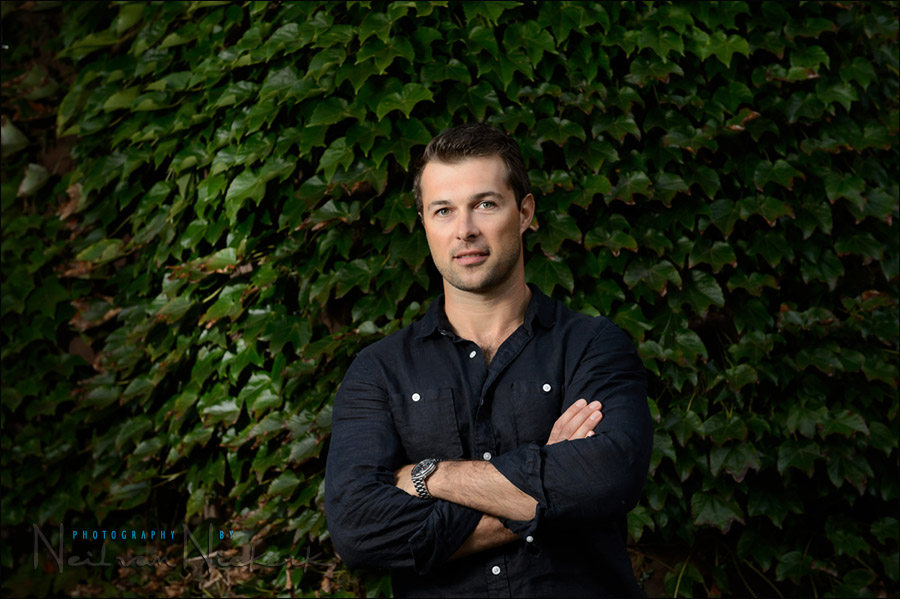
Thoughts on using a beauty dish as a single light source
A beauty dish is one of those light modifiers that sound attractive just by name already. And when photographers start exploring other options than direct off-camera flash and umbrellas or a softbox, a beauty dish is usually one of the first alternate light modifiers that catches attention. Mine too. Right after I bought my first Profoto kit, I purchased a beauty dish for it and started exploring using a beauty dish.
A beauty dish is ideally used at a closer distance for portraits, with the light “focused” on the face, creating a gradient where the light rapidly falls off between the lighter and darker areas – yet looks soft where the light is focused. But there’s more to it than that – a beauty dish is best used with a grid to help control the light. Or used with a sock, but then the beauty dish acts very much like a round softbox, and some of its specific qualities are lost.
Quite a few of the softbox options for speedlights offer a way to create a beauty dish-like effect. An example is the Westcott Rapidbox – 26″ Octa Softbox (affiliate), as mentioned in the review: Westcott Rapid Box 26″ Octa Softbox. You can take the front diffuser off and add the Westcott 2030-DP Deflector Plate (affiliate), turning it into a beauty dish of sorts. But the same limitations appear.
Looking at the portrait of David above, you’ll notice a semi-circular band of light to the left. This is because, even though the light from the beauty-dish-ified softbox focuses light on him, there is light that spills from the edge of the speedlight. The detail photo of the Westcott RapidBox will explain it better …
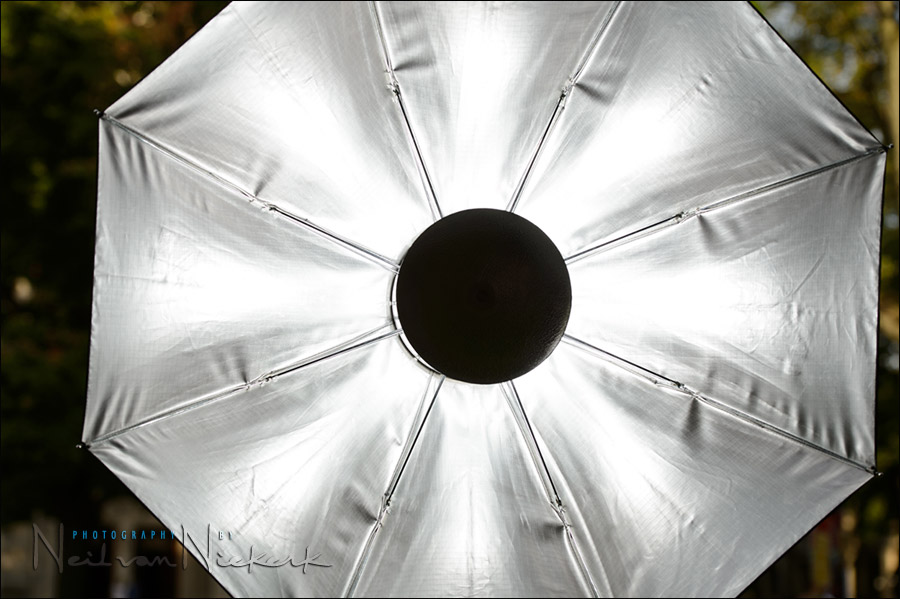
This is how the light is spread with the deflector plate in the middle. The light is now bounced into the octa-box, giving nearly a beauty dish type of light.

However, when you move to the side, you’ll see there is direct light spilling from the speedlight. This is what caused that semi-circular band of light. Hard direct flash.
This pull-back shot will show the circular spill light better. And there is also a comparison photo of the available light, with the aperture opened up to f/4 instead of the f/5.6 used in the final images with the softbox.
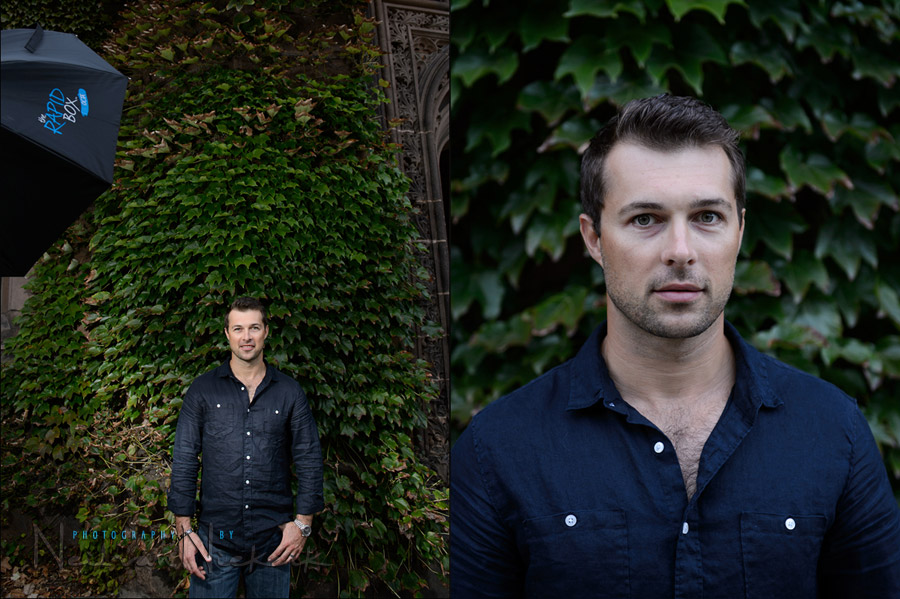
With the final images of David, I was able to use that spill light for effect, by controlling the composition.
Photo gear (or equivalents) used during this photo session
- Nikon D4
- Nikon 24-70mm f2.8G AF-S / Canon 24-70mm f/2.8L II
- Nikon SB-910 Speedlight / Canon 600EX-RT Speedlite
- Westcott Rapidbox – 26″ Octa Softbox
- Westcott 2030-DP Deflector Plate
- Manfrotto 1052BAC – medium light-stand
Related articles
- review: Westcott Rapid Box – 26″ Octa Softbox
- Flash photography tutorial
- Camera & flash settings: what do you want to achieve?
Using a beauty dish in the studio as a single light source
While the above example was shot with a speedlight softbox that was adapted, let’s have a look at what a beauty dish does in the studio when used as a single light source.
In this first example, it was just the Profoto beauty dish on Anelisa, with no grid or sock on it. The pull-back shot shows the placement relative to her. The light on her face has the typical light of a beauty dish (for that distance) … but if you look at her hands, you’ll notice a much harder light.
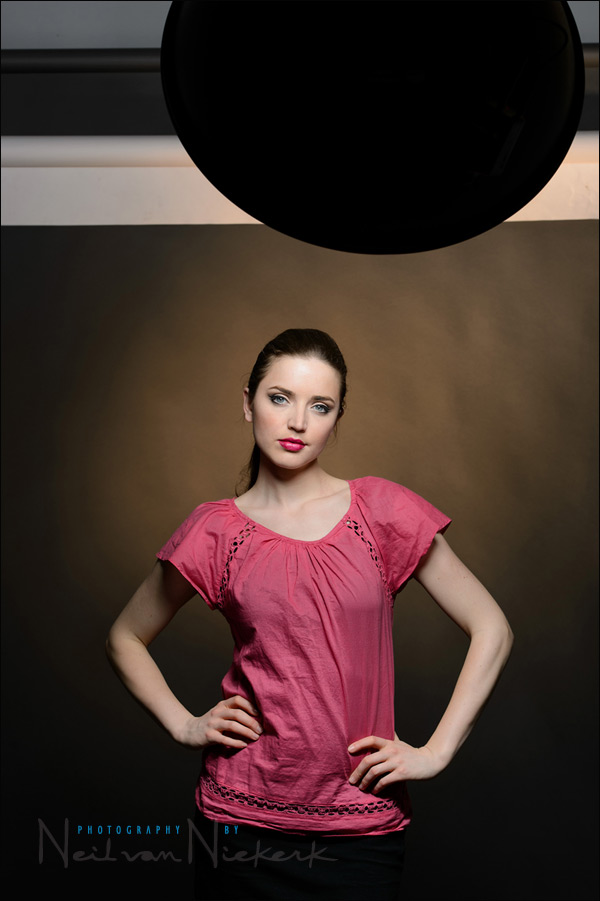
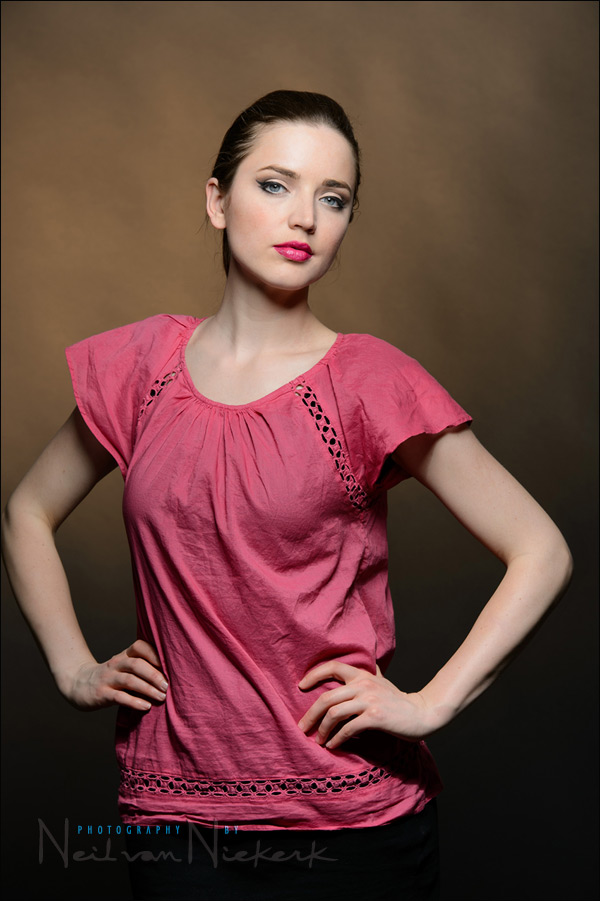
On the closer portrait here, you’ll notice how the light on her face is different than on her hands … which was the direct flash from the flash-head in the beauty dish.
The next example shows the effect of the beauty dish with a sock over it. Now the light is much more even, and there is none of the direct flash spilling from the edge.
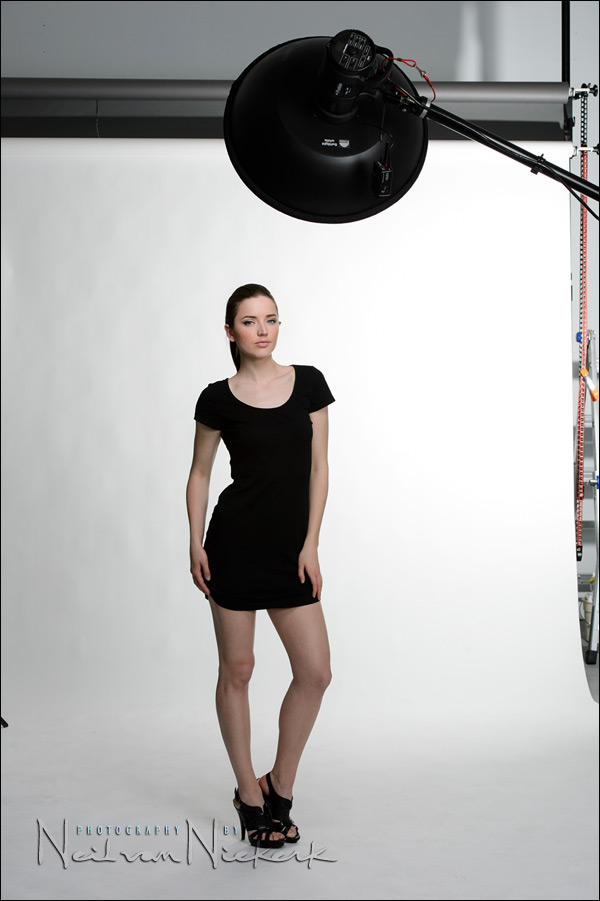

Summary
To avoid this effect of the direct flash spilling from the edge, you need to shoot a tight portrait with the Profoto beauty dish (affiliate) … or use a diffuser sock (affiliate) for the beauty dish; or use a grid, such as the honeycomb grid (25 degrees) (affiliate). The grid will contain that light, but still keep the essential look of the beauty dish.
Then of course, a beauty dish makes a lot of sense used in a multiple-light setup in the studio, adding an accent to the light on your subject’s face. And we’ll come back to that in follow-up articles in the future.
Profoto beauty dish and accessories
- Profoto beauty dish
- Diffuser sock for the beauty dish
- Profoto 25 degree honeycomb grid
Related articles
- Using the beauty dish as a single light source
- Low-key lighting for a dramatic portrait
- Using a beauty dish (Janine vN)
Hey Neil, I noticed that they sell silver and white beauty dishes, could you explain the differences and which is a better choice? I understand that they white gives a larger beam spread, but is it also softer?
Jessica .. I don’t have immediate experience of this, but from what I’ve read it would appear that the silver beauty dish gives a more specular sheen to the skin. Most likely quite subtle.
Neil, would using the 26″ Octa’s front diffuser along with the diffuser plate have a comparable affect to using a sock on the beauty dish?
Yes, they will give similar looks, because both of those will now be softboxes.
Hi Frank,
I also have the same softbox with the plate add-on, and I tried your method a while back. Using the front diffuser with the plate together takes away that “light look” of beauty dish. For me, they just help manage hot spot better.
Neil, thanks for the great tutorials. Would using a (DIY) short snoot or your BFT on the flash possibly minimize the flash spill? Would zooming in help?
I have no idea how you’d even fit all that in there.
Zooming won’t help, because if you looked at the octabox from the side, you’d still see the flash-head.
Unless the Rapid Box diffuser stops more light than the typical sock on a Beauty Dish, I would have thought that the diffuser would be the equivalent of a sock. Dewey’s usage on a Westcott Rapid Box Octa is interesting to note.
Hi Neil,
Did you see if changing the zoom on the flash or position of flash improves the band at all on Westcott box?
Fawaz
Zooming won’t help, because if you looked at the octabox from the side, you’d still see the flash-head.
I just typed a response and lost it – thank god it’s “talk like a Pirate day” because… Aaaargh!
OK – Thanks Neil – great post, especially identifying the semi-circle of light. Which leads me to a question about the sock… as I made my own Beauty Dish ) I don’t have a sock and I was wondering whether the material is the same as a softbox front panel or indeed more of an opaque white stocking like material? I am thinking the latter.
If so I can cut out a circle and have my wife (!) sew in some elastic to fit over t he 16″ diameter dish!
Thanks again!
Jon
Yes …. and then you’ve made a circular softbox.
Hi Neil. Thanks for the post. I am wondering where the face-shaping specular highlights are coming from. They look too narrow to be from kickers in the side and back. Did you get the BD to be really soft in the front face but creating highlights on the sides of her face? If so, can you explain. Thanks!
Those highlights on her face (in the bottom photograph) is light reflected from the white backdrop. For the studio shots, I had lights on the backdrop.
Hi Neil!
I made my own beauty dish some years ago and never had the light spill problem that you have. I think it’s because the reflector was simply a little closer to the light source (in my case a speedlight) than what you have it. Wouldn’t you be able to control that spill by bringing the reflector a little closer to your light source, or is it fixed?
Just for reference, here is a link to how I made my beauty dish: http://thephotophile.blogspot.se/2010/10/diy-beauty-dish-on-cheap.html The results were actually quite good!
Have a great day!
Lanthus
Hey Neil, just wondering how do you feel about those beauty dishes that go around the lens itself? Better or worse than the kind you have here?
You mean a ring-flash?
Keep in mind that an off-camera light source will look different than a light source on the axis as your lens.
Do I need to buy a different stand for beauty dish or i can use my speedlight stand ?
Nope, whatever you have should be fine. The beauty dish should come with a way to clamp it to the light-stand.
Neil – Quick question. What are you using in the pull-back (BTS) shot in this article to secure the strobe to the boom arm? It’s a red colored bungee or strap of some sort and may I ask what is it looped through on the boom arm itself?
Thanks!
Darius
Oh, the orange thing you’re seeing there is actually in the background – it is the plastic gear-chain with which the paper backdrops are rolled up and down, It’s not connected to the boom arm at all.
The Profoto beauty dish was on a Manfrotto 025BS boom w/ 008BU stand & casters which offers coaxial geared controls at the one end. So now it is possible to adjust the positioning of the light such as the beauty dish in this case, without having to get on a ladder.
Neil,
Thanks for your response and apologize it took so long for me to find this thread again to read your reply from February, but what I was referring to was the safety harness/cable that is running through the Profoto D1 strobe’s handle. It appears to secured to the boom somehow. What piece of the boom is it looped through or around? I would like to have a similar solution to ensure the strobe has a safety cable.
Thanks,
Darius
Thanks for the article. I recently stepped away from soft boxes and umbrellas finally. I’ve been scratching my head trying to figure out what that band of light is in my photos as the center was diffused. So now I know I have to account for spill light.